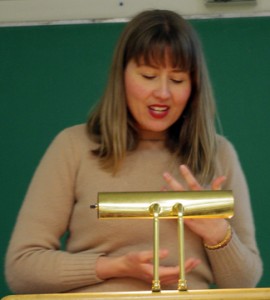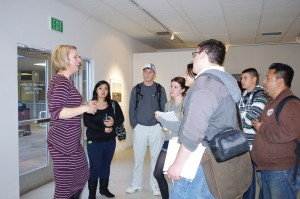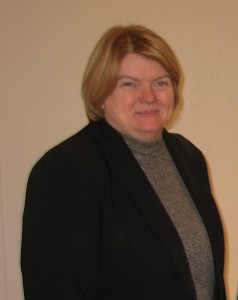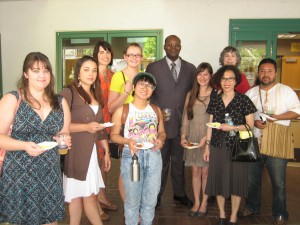Guest Lectures: Spring 2012, CSUS Art Department
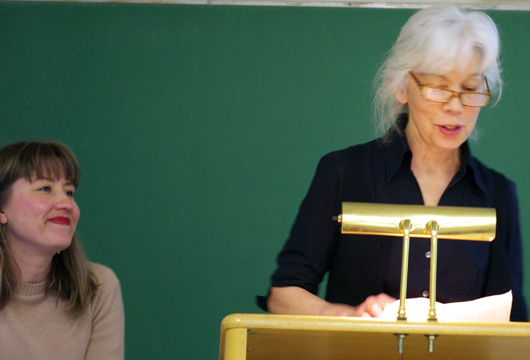
Throughout the spring 2012 semester, Elaine O’Brien, CSUS Art History Professor, arranged a series of guest lectures delivered by visiting professionals. The following is a round-up of those sessions.
LIV MOE
On Tuesday, March 13, 2012, the annual “Professions of Art” lecture series kicked-off with a lively talk delivered by Liv Moe, the Executive Director of Sacramento’s Verge Center for the Arts. Moe, who is also a visual artist and writer, was the first guest speaker to lecture during the spring semester. Professor Elaine O’Brien introduced Moe to the audience by asserting that the success of the Verge is directly due to Moe’s efforts and collaborative skills. Under Moe’s leadership, the Verge, an innovative art space for artists’ studios and contemporary art events, received a prestigious arts grant and has formally achieved non-profit status. In recognition for her work at the Verge, the Sacramento Arts and Business Council recently named Moe “Arts Executive of the Year.”
In her lecture, Moe described the path that led her from a Fargo, North Dakota childhood to the center of the Sacramento art world. She explained, “In high school I was the arty kid, but my work was really bad.” Moe learned how to paint from her mother, who is also an artist. But more importantly, from her mother, Moe picked up the habit of always keeping herself busy with projects. She now juggles her personal studio-art time with project management duties at the Verge, including fundraising, marketing, promotion and event planning.
A solid education in the arts played a major role in Moe’s career trajectory. She earned a B.A. in Art Studio from U.C. Davis, and a Masters of Art from CSUS. Moe started out as a Sociology major, but after taking an art class she switched her major to Art. She created her first sculptural project, a stack of books, for an assignment that asked, “What do books innately do?” Said Moe, “That first art class was my portal into the world.” Even though she found herself in the company of students with more art experience than herself, she said, “I was excited to go to school and learn more.”
During graduate school Moe edited and wrote articles about the local art scene for the monthly publication, Mid- town, which she and her husband Tim Foster produced. Midtown made Liv and Tim the voice of the local culture and gave her the wide view needed to the void in Sacramento’s art world. She thought, “Why must a new mall or a new arena make Sacramento great?” She has worked passionately ever since to push art to the forefront. Her mission at the Verge is two- fold: first to provide vital resources to local artists; and second, to bring international recognition to local contemporary artists.
Moe honed her gallery administration skills while working for Verge in their original 14,000 square foot space on V and 19th. In 2008, she was responsible for the conception and implementation of Verge’s successful show, Hitchhikers and Other Work, featuring 300 photographs by Doug Biggert. In 2010, Moe steered the relocation of the Verge to its present 22,000 square foot warehouse facility that now includes over twenty artists’ studios and plenty of exhibition and event space.
Often referred to as an art incubator, the Verge under Moe’s leadership is at the leading edge of providing much needed resources to Sacramento’s contemporary art scene. Said Moe, “One of the biggest values to the new space is the studios. It also provides the opportunity for the community at large to come in and interact; it starts making art part of everyday life – which I think is essential.”
JENNY STARK
On April 3, 2012, Jenny Stark, photographer, filmmaker and videographer, CSUS Associate Professor and Coordinator of Film Studies, discussed her recent film and photo projects along with her concurrent exhibition, In Between Place: Jenny Stark’s Central California. Following her lecture, Stark led the audience on a tour of her new series of landscapes and interiors on view in the Else Gallery from March 6 to April 3. She explained to the assembled group, “I’m always thinking about identity and I always start with place; then I start thinking about place as part of my art.”
For the exhibition statement, Stark wrote that, “In some ways these photos are about Central California as a place between destinations like Tahoe, San Francisco and Los Angeles. They are also partial narratives created by things left behind and by the fragility of a debt economy. Uninhabited homes in Sacramento and Stockton, unfinished developments in Natomas, levees and pumping stations in the Delta region, all reflect a sense of instability.”
Stark, a native of Bellaire, Texas, earned a BFA in Photography from the University of Houston and an MFA in Film and Video from the California Institute of the Arts. Her films have been shown at South-by-Southwest in Austin, Texas, The New York Underground Film Festival, The Viennale in Vienna, the L.A. Film Forum, and the Museum of Contemporary Art in Mexico City. Stark’s work was recently showcased in an exhibition and film screening at the Crocker Museum and again on U-Nite, April 12.
LIAL JONES
Lial Jones was the sixth lecturer to speak in the CSUS Art History Department’s two-semester series Professions of Art. Jones focused her April 10th lecture on the path taken from childhood to her current position as Director of Sacramento’s Crocker Art Museum, playfully giving her talk the title “My Brilliant Career” after the well-known Australian film by Gillian Armstrong. Professor Elaine O’Brien introduced Jones by describing her as one of the most influential art administrators in Northern California. O’Brien added that, “Under Lial Jones’ guidance, the Crocker has become a rich resource for us.”
Citing her mother as her biggest influence in life, Jones remembers that even as young as six months old, she was “intently focused” on objects. Approaching objects of visual culture creatively is an idea Jones finds powerful. “For me, there has always been a power and draw to museums, even from an early age,” said Jones. That attraction has stayed with her throughout her life. Explained Jones, “It’s the story of the object that makes a museum come to life for people. It’s not just about the dates of works of art.”
Jones began volunteering in museums when she was in high school. By the time she was eighteen, she was hired as a tour guide at the Lorenzo Museum in Cazenovia, NY. Jones earned a BA in American Studies from the University of Delaware where she learned that she would never make much money working in a museum. Obviously that did not deter her from pursuing a career in museum related work. She went on to earn a degree from the Museum Management Institute at UC Berkeley. For nearly twenty years, Jones worked at the Delaware Art Museum in Wilmington, where she rose from contemporary art curator to Deputy Director of the museum.
In 1999 Jones was hired as Director of Sacramento’s Crocker Art Museum. At the time, Jones recalls that “the mu- seum was rather moribund and the staff was not unified.” She was hired to change the museum. Under her direction, the Crocker built a state of the art wing enlarging the museum from a 50,000 square-foot facility to one that is now 151,000 square feet. The Crocker art collection nearly doubled from 9,000 works of art to over 16,000 works. Museum attendance grew from 99,000 visitors a year to over 250,000 under Jones’s leadership. She has also steered the museum’s budget from $2.2 million to $9.4 million.
Jones said, “The Crocker Art Museum is now something Sacramentans can be proud of. It is a vibrant cultural center.” She envisions the Crocker as “the jewel of Sacramento.” Jones told the audience, “My passion and experience are the number one reasons I have been successful in Sacramento.” Her advice to students who wish to pursue museum careers is to start volunteering now. She said that content knowledge is important but one must also know the history of art and visual culture. Jones said, “Don’t be afraid to express sheer delight in what you are seeing.”
As for the future of the Crocker, Jones said “We’re not a tourist city but I would like to see more of a regional draw from San Francisco. As a regional art museum we have a responsibility to artists of this region to collect and show their work. But we also want to bring in work people may not see unless they fly to Chicago.” She concluded her lecture saying, “Because we’re in the capital of California, people think we will be the center of the art world and we’re in a good position to take advantage of that.”
SYLVESTER OGBECHIE
The annual CSUS “Festival of the Arts” culminated with a didactic lecture from Professor Sylvester Ogbechie on April 21, 2012. A professor of art history and architecture at UC Santa Barbara, Dr. Ogbechie addressed the standing room only crowd with a very serious issue: “Art Collections, Museums & Preservation of Cultural Heritage in Africa.” As both a scholar in African arts and as a native of Nigeria, Dr. Ogbechie spoke with authority and from personal experience. Dr. Ogbechie told the audience that Nigeria, a country known for its indigenous arts, has been looted of its cultural heritage. He explained that nine-tenths of known African sculptures originated in Nigeria but are now on held illegally and are displayed in western museums.
The most important works, and the focus of his discussion, are the so-called Benin Bronzes. In 1897 the British burned the Palace of Oba in the kingdom of Benin and looted it of artworks including ivory and important ceremonial bronze objects. Dr. Ogbechie shared photos depicting British soldiers blatantly posing with stolen bronze works made for the king of Benin. Said Dr. Ogbechie, “They represent a massive plunder of indigenous wealth; all works from and for Benin kings.” He explained, that today a good Benin Bronze object could sell for tens of millions of dollars. Said Dr. Ogbechie, “The appropriation of African cultural objects results in an active transfer of equity and cultural works.”
The Nigerian government’s attempts to reappropriate stolen treasures, for display in their own museums, have continually been rebuffed. Dr. Ogbechie said that the British people have forbid the British Museum from returning the artwork to Nigeria. One option for the Nigerian government would be to take their case to court in America, but Dr. Ogbechie said that would require a huge financial investment.
CRAIG WATSON
Can a studio art major amount to anything in the “real” world? According to Craig Watson, the answer is, “absolutely.” Watson, who was the spring semester’s final speaker in the ongoing Professions in Art lecture series, is the Director of the California Arts Council, the official state arts agency. During the course of the May 8th lecture, Watson gave an account of the choices he made throughout his life that led him to where he is today. “For me,” he explained, “good outcomes are not due to a linear path.” Watson told the audience that he didn’t end up exactly where he expected to be in life.
Where he is today is at the helm of a council that puts money into the arts throughout the state of California. That includes distributing one million dollars to artists-in-residence programs and one million dollars to local arts councils in all fifty California counties. It’s a job that Watson likes, despite the fact that California ranks 49th out of 50 in terms of money spent by individual states across the country. (The bottom of the list rank is based on the fact that Kansas is the only state without an arts council.) Ironically, California has more working artists than any other state. Said Watson, “It’s shameful that our state doesn’t invest more in the arts…. What’s great about working for the 49th out of 50, is the challenge -– we have no place to go but up.”
Watson was chosen as director of the Arts Council after a nationwide search. “I am not the usual suspect,” said Watson who went on to explain that he was hired for his background and skill even though he had no direct experience working in a government bureaucracy. His prior professional experience includes numerous arts council positions at the local level, followed by a career in telecommunications in Rhode Island, New York and California.
The son of a minister, Watson listed four events that were important steps in his career path. First, as a fifth grader, he appeared on the Art Linkletter show “Kids Say the Darndest Things.” Dressed as Thomas Jefferson, Watson was unprepared for a question from Linkletter and went home embarrassed, but with a valuable life lesson. Second, during a family trip to Mexico, Watson discovered the famed Mexican muralist Diego Rivera. The third seminal event for Watson was when he ignored advice from a high school guidance counselor by choosing public speaking and typing classes over advanced chemistry. And fourth, Watson was one of 300 people hired by the artist team Christo and Jeanne-Claude to build the Running Fence across Marin and Sonoma Counties, California in 1976.
“For me,” said Watson, “these choices led to important moments in my life.” From the Linkletter show he learned that real preparation matters and that, “the best defense against a curve ball is to be ready.” All that he understands about the global world, he learned from his trip to Mexico. He said, “You must challenge yourself about other cultures.” The speaking and writing skills he learned in high school have served him well. Said Watson, “very few can survive solely as studio artists (Watson was a studio art major in college). From Christo and Jeanne-Claude, Watson learned the power of process. Explained Watson, “Everything you do has a process that leads to chances of success. Christo impressed upon me the power of process and mastering it for big impact.”
Watson concluded his lecture with a few words of advice to students: “Network like your future depends on it; mentors matter; internships matter; keep your imagination alive; and, don’t be the usual suspect in your own life.”
